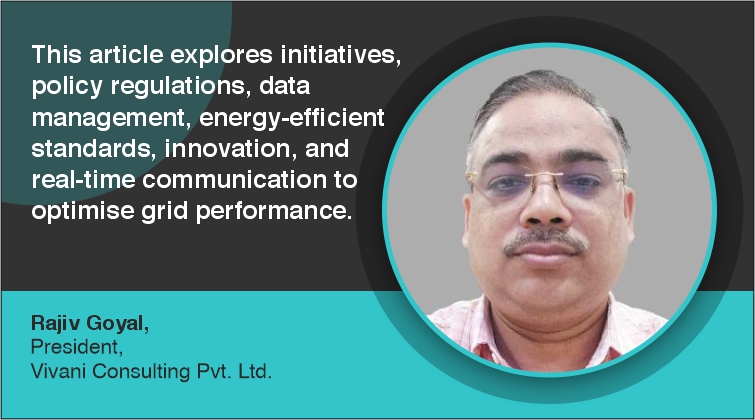Improving grid efficiency and resilience via digitisation and integration
By EPR Magazine Editorial June 29, 2023 2:27 pm IST
By EPR Magazine Editorial June 29, 2023 2:27 pm IST

The power grid in India faces numerous challenges, including frequent failures in transmission and distribution systems, voltage fluctuations, and coordination issues between different departments. It is crucial to adopt a transformative approach to overcome these challenges and create a more efficient and resilient grid. In this technical article, Rajiv Goyal, President at Vivani Consulting Pvt. Ltd., explores key initiatives, policy regulations, data management, energy-efficient standards, innovation, and real-time communication to optimise grid performance.
The Ministry of Power has set a goal to provide smart meters to 25 crore consumers, resulting in a data-rich grid. This extensive network will enable comprehensive data collection, including weather and feeder systems, and facilitate valuable insights through GIS mapping tools. Installing feeder Remote Terminal Units (RTUs) further enhances data collection capabilities. Additionally, the government aims to meter all Distribution Transformers (DTs) by 2025, although the progress currently stands at 20-25%. The SAMAST scheme focuses on Availability-Based Tariff (ABT) meter data, providing essential information on scheduled and consumed power.
Transition to Renewable Energy and Tariff Regulations
India’s commitment to achieving Net Zero by 2070 requires significant integration of renewable energy (RE). By 2030, the grid is projected to have nearly 300 GW of RE, with a substantial portion generated within city areas. To facilitate this transition, Time-of-Day (TOD) tariff regulations have been implemented, offering dynamic tariffs to commercial, industrial, and Critical National Infrastructure (CNI) consumers through state commissions. Moreover, green energy Open Access regulations allow free transmission capacity, net metering, and net building. State-level implementation of EV charging infrastructure and policies, along with separate EV tariffs provided by state DISCOMs, further supports the adoption of electric vehicles.
Energy-Efficient Standards and Innovation
Establishing energy-efficient technical standards is crucial to minimise losses and improve grid efficiency. Emphasising compliance for transformers, cables, and conductors can significantly reduce technical losses. To foster innovation, investments in research and development should be prioritised, and suitable funding should be allocated through the central government budget. Technologies such as the Internet of Things (IoT), machine learning, artificial intelligence, and blockchain have the potential to revolutionise grid operations and enhance efficiency.
Data Management and CybersecurityEffective data management is essential for grid optimisation. A comprehensive national policy is required to centralise data collection and storage, ensuring proper coordination and safeguarding against cybersecurity threats. A centralised national agency should collect data from various Grid Elements, including smart meters while limiting access to authorised agencies to prevent data breaches and criminal activities. Utilising this data, national-level policies can be formulated to drive grid improvements and informed decision-making.
The adoption of advanced technologies
Adopting advanced techniques like drones and thermal cameras can significantly enhance maintenance practices. Aerial inspections using drones and thermal cameras during the summer season enable the detection of faulty insulators on overhead lines and facilitate timely interventions through predictive maintenance strategies.
Real-time communication between devices and the control system is paramount for efficient grid management. Strategic placement of sensors enables remote monitoring and control of critical components such as breakers, transformers, batteries, and isolators from control rooms. Integrating CCTV, firefighting, and alarm alert systems with SCADA systems at DISCOMs ensures comprehensive monitoring and quick response capabilities.
The optimisation of India’s power grid necessitates a comprehensive approach that embraces digitisation, integration, and innovation. The grid can become self-explanatory, proactive, and resilient by leveraging smart meters, advanced data analytics, IoT, and emerging technologies. With a focus on energy-efficient standards, real-time communication, predictive maintenance, and seamless integration, the power grid in India can meet the evolving demands of a rapidly developing nation while ensuring an uninterrupted and reliable electricity supply.
We use cookies to personalize your experience. By continuing to visit this website you agree to our Terms & Conditions, Privacy Policy and Cookie Policy.